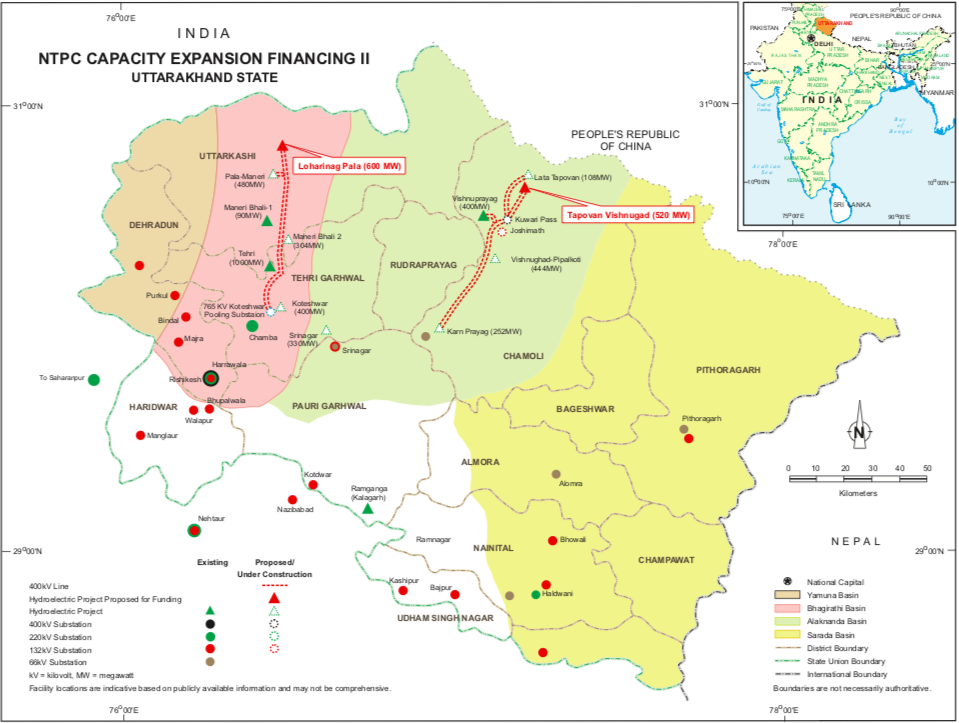A disaster struck the Himalayan state of Uttarakhand at 10.45 am today as a glacier burst and avalanche in Joshimath area of Chamoli district has triggered massive flash floods. Two hydro power project dam sites are also affected, as tweeted by the state chief minister, Trivendra Singh Rawat.
A disaster was reported at Raini village at around 1045 am, affecting two dam sites in Chamoli. Immediate instructions were issued to take stock of the situation and take emergency measures. Simultaneously, state’s disaster response mechanism was activated. #Uttarakhand
— Trivendra Singh Rawat (@tsrawatbjp) February 7, 2021
As per the reports, Rishi Ganga hydro power project of NTPC Ltd, which is under construction near Reni village, has suffered damages. Unconfirmed reports claim Tapovan dam has breached and over 150 labourers working at the power project are missing. In the past, local villagers had been protesting against the construction of these dams, which they felt were environmentally unsound.
Water level in Dhauli Ganga river, a tributary of Alaknanda, which further forms the Ganga, has risen by several metres.
चमोली के रिणी गांव में ऋषिगंगा प्रोजेक्ट को भारी बारिश व अचानक पानी आने से क्षति की संभावना है। नदी में अचानक पाने आने से अलकनंदा के निचले क्षेत्रों में भी बाढ़ की संभावना है। तटीय क्षेत्रों में लोगों को अलर्ट किया गया है। नदी किनारे बसे लोगों को क्षेत्र से हटाया जा रहा है।
— Trivendra Singh Rawat (@tsrawatbjp) February 7, 2021
Rescue operations by ITBP (Indo Tibetan Border Police) and NDRF (National Disaster Response Force) are underway. Villages along the rivers’ downstream routes are being warned and evacuated.
किसी भी आपातकाल की स्थिति से बचने के लिए हमें सतर्क रहना होगा। नदी के आसपास के लोगों से अपील है कि बेचैन न हों। शांत दिमाग़ से और सूझबूझ से काम लें। ख़ुद को किसी सुरक्षित स्थान पर ले जाएँ जबतक ख़तरे का अंदेशा है। pic.twitter.com/SP7a407YAh
— Uttarakhand Police (@uttarakhandcops) February 7, 2021
— Chamoli Police Uttarakhand (@chamolipolice) February 7, 2021
तपोवन में रेस्क्यू कार्य जारी।
— Chamoli Police Uttarakhand (@chamolipolice) February 7, 2021
पुलिस प्रसाशन मोके पर। pic.twitter.com/OuQT3wEVz5
“From the left of river Dhauli Ganga, its tributary Rishi Ganga comes from the core of the Nanda Devi Biosphere. It is estimated that a glacial lake must have formed in its upper catchment or the glaciers broke causing the avalanche. Since it is a difficult terrain, only foresters visit once every 10 years, no expeditions are allowed in this region,” Saraswati P Sati, professor and head department of basic and social science, College of Forestry, Ranichauri, Tehri Garhwal (VCSGUUHF, Bharsar) told Gaon Connection.
This disaster struck today morning near Reni village in Chamoli, which is the birthplace of the famous Chipko movement that began in 1974. At the confluence of the river Dhauli Ganga is the Rishi Ganga Hydropower project. This project is constructed in the buffer zone because of which the locals protested in the past. Due to the current avalanche, the entire project has been damaged. Further ahead, another hydropower project too has been damaged. The damage can be also seen further ahead in Vishnuprayag (downstream).


“What is most shocking is that the Uttarakhand government and the Central government, as a number of hydro power projects there are central government projects, have been caught completely unaware,” Himanshu Thakkar, coordinator of South Asia Network on Dams, Rivers & People told Gaon Connection. “We still do not know where did the disaster originate from and what is the cause and why there were no warnings and why we still do not have clear picture. Why the under construction project got damaged so easily in an off season event?” he asked.
Experts point out that had such a disaster struck in monsoon season, when the rivers are already carrying huge amounts of water, it could have led to large-scale devastation. At present, it is off season (winter) and rivers have minimum water levels.
According to news reports, in October 2013, a high-power monitoring committee was set up by the Union Ministry of Environment Environment and Climate Change. This Supreme Court committee in its report deemed 24 hydropower projects on the Alaknanda and Bhagirathi rivers in Uttarakhand to be ecologically damaging.
The state chief minister Rawat said he was closely monitoring the situation. Those struck by the disaster can reach out to the helpline numbers 1070 or 9557444486 for rescue.
अगर आप प्रभावित क्षेत्र में फंसे हैं, आपको किसी तरह की मदद की जरूरत है तो कृपया आपदा परिचालन केंद्र के नम्बर 1070 या 9557444486 पर संपर्क करें। कृपया घटना के बारे में पुराने वीडियो से अफवाह न फैलाएं।
— Trivendra Singh Rawat (@tsrawatbjp) February 7, 2021
According to the home minister Amit Shah, more teams of NDRF are being airlifted from Delhi and sent to Uttarakhand for rescue operations. Prime minister Narendra Modi is also monitoring the rescue operations.
NDRF की कुछ और टीमें दिल्ली से Airlift करके उत्तराखंड भेजी जा रही हैं। हम वहाँ की स्थिति को निरंतर मॉनिटर कर रहे हैं। https://t.co/BVFZJiHiWY
— Amit Shah (@AmitShah) February 7, 2021
Am constantly monitoring the unfortunate situation in Uttarakhand. India stands with Uttarakhand and the nation prays for everyone’s safety there. Have been continuously speaking to senior authorities and getting updates on NDRF deployment, rescue work and relief operations.
— Narendra Modi (@narendramodi) February 7, 2021
Just last month, on January 15, more than seven years after the deadly 2013 floods in the state that killed more than 5,000 people, Uttarakhand got its first doppler weather radar. This radar, now functional at Mukhteshwar, about 300 kilometres from the state capital Dehradun, is meant to help forecast weather and predict extreme weather events.
With inputs from Megha Prakash from Dehradun, Uttarakhand.


















